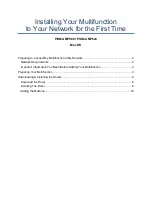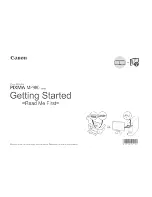
To help avoid paper jams and poor print quality:
•
Always
use new, undamaged paper.
•
Before loading paper, know the recommended printable side of the paper. This information is usually indicated on
the paper package.
•
Do not
use paper that has been cut or trimmed by hand.
•
Do not
mix paper sizes, types, or weights in the same tray; mixing results in jams.
•
Do not
use coated papers unless they are specifically designed for electrophotographic printing.
Selecting preprinted forms and letterhead
Use these guidelines when selecting preprinted forms and letterhead:
•
Use grain long for 60–90 g/m
2
(16–24 lb) paper.
•
Use only forms and letterhead printed using an offset lithographic or engraved printing process.
•
Avoid papers with rough or heavily textured surfaces.
Use papers printed with heat
‑
resistant inks designed for use in xerographic copiers. The ink must be able to withstand
temperatures up to 230°C (446°F) without melting or releasing hazardous emissions. Use inks that are not affected by
the resin in toner. Inks that are oxidation
‑
set or oil
‑
based generally meet these requirements; latex inks might not.
When in doubt, contact the paper supplier.
Preprinted papers such as letterhead must be able to withstand temperatures up to 230°C (446°F) without melting or
releasing hazardous emissions.
Using recycled paper and other office papers
Recycled office paper produced specifically for use in laser (electrophotographic) printers may be used in your printer.
However, no blanket statement can be made that
all
recycled paper will feed well.
Generally, the following property guidelines apply to recycled paper.
•
Low moisture content (4–5%)
•
Suitable smoothness (100–200 Sheffield units, or 140–350 Bendtsen units, European)
Note:
Some much smoother papers (such as premium 24 lb laser papers, 50–90 Sheffield units) and much
rougher papers (such as premium cotton papers, 200–300 Sheffield units) have been engineered to work very
well in laser printers, despite surface texture. Before using these types of paper, consult your paper supplier.
•
Suitable sheet-to-sheet coefficient of friction (0.4–0.6)
•
Sufficient bending resistance in the direction of feed
Recycled paper, paper of lower weight (<60 g/m
2
[16 lb bond]) and/or lower caliper (<3.8 mils [0.1 mm]), and paper
that is cut grain-short for portrait (or short-edge) fed printers may have lower bending resistance than is required for
reliable paper feeding. Before using these types of paper for laser (electrophotographic) printing, consult your paper
supplier. Remember that these are general guidelines only and that paper meeting these guidelines may still cause
paper feeding problems in any laser printer (for example, if the paper curls excessively under normal printing
conditions).
Paper and specialty media guide
54
Summary of Contents for eS305CP
Page 125: ...2 Open the top door 3 Remove the toner cartridges Maintaining the printer 125 ...
Page 130: ...16 Insert the waste toner bottle 17 Insert the right side cover Maintaining the printer 130 ...
Page 134: ...2 Open the top door 3 Remove the toner cartridges Maintaining the printer 134 ...
Page 138: ...14 Insert the waste toner bottle 15 Insert the right side cover Maintaining the printer 138 ...
















































